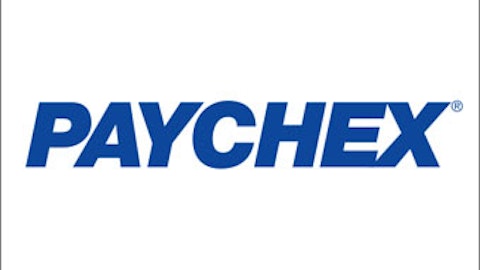
Positioning yourself for rising rates isn’t easy. Some say the best way to play higher rates is in complex ETFs like ProShares UltraShort 20+ Year Trea (ETF) (NYSEMKT:TBT), which tracks inversely (and then doubles!) the change in daily Treasury prices. Shorting treasuries will make you money as rates rise, but daily compounding can throw off odd results.
A better way to make the play is in stocks that make more money as rates go higher – companies that generate a free float on their customers’ cash.
Here are two companies that do just that.
Automatic Data Processing (NASDAQ:ADP)
What’s payroll and human resources have to do with interest rates? Not all that much, to be honest– but the company does generate an impressive float.
In 2012, Automatic Data Processing (NASDAQ:ADP) reported having $18 billion of customer cash on its balance sheet. ADP receives cash from employers, then prepares payroll checks, direct deposits, and produces all necessary tax information. In between receiving cash from employers and the time that cash is claimed by employees, Automatic Data Processing (NASDAQ:ADP) generates an investment return on the capital.
This can add significantly to Automatic Data Processing (NASDAQ:ADP)’s earnings. $18 billion invested at 4% is $720 million. In the most recent full year (2012) ADP earned only 2.8% on client funds. That number will only go lower as its maturing securities are reinvested in lower-yielding U.S. Debt yielding around 2% for 10 years. Rising rates, though, would propel bottom line growth.
What’s most important is how this company is essentially double-levered to rising rates. Interest rates will rise only with expansion in the economy. Given Automatic Data Processing (NASDAQ:ADP)’s exposure to employment (more employees means more payroll processing revenue), upside comes in two forms.
Automatic Data Processing (NASDAQ:ADP), unfortunately, is not cheap. Investors favor it for its wide moat and pricing power, but at 21 times forward earnings it’s not especially expensive, either. A combination of rising rates and improving employment make it a compelling play. Besides, you’ll get paid to wait to the tune of 2.5% a year, or 44 cents per quarter in dividends.
Federated Investors Inc (NYSE:FII)
This asset manager is one of the biggest publicly-traded fixed-income managers on Wall Street. The company has more than $380 billion in assets under management, which is divided into a mix of fixed-income, money market, and equity funds.
All told, $300 billion of its assets are in fixed-income and money market funds, both of which have upside on rising rates. Zero interest rate policy from the Federal Reserve forced Federated Investments to take a loss on its money market accounts. The company slashed fees and loses millions in the business each year with the hope that, one day, rising rates will allow for new and higher fund management fees.
Supposing that Federated Investors Inc (NYSE:FII) could add 5 basis points in fees to its funds on rising rates, the company would add a respectable $150 million to its bottom line profit. Ten basis points would add $300 million. Federated Investors Inc (NYSE:FII) reported $188 million in net income in 2012. Thus, rising rates and rising fees could lead net income to double.
Federated Investors Inc (NYSE:FII) trades at a relative discount to the market at 12.8 times 2012 earnings. While asset management is no spectacular business, especially in fixed-income lines, the business isn’t poor enough to warrant a discount to the market as a whole. Higher rates bring a catalyst, which should bring rising stock prices on the back of increasing fee revenue and multiple expansion. A dividend of 4.2% per year seals the case for buying and waiting.
Are higher rates on the horizon?
Leave interest rate policy forecasting up to the dartboard. Investors have suggested that rates would go higher every year since the Fed began quantitative easing, but rates have only gone lower. Positioning your portfolio in companies that see an earnings bump during periods of higher interest rates is a better play than a concentrated bet on falling U.S. Treasuries.
The article Two Plays for Higher Interest Rates originally appeared on Fool.com and is written by Jordan Wathen.
Copyright © 1995 – 2013 The Motley Fool, LLC. All rights reserved. The Motley Fool has a disclosure policy.

